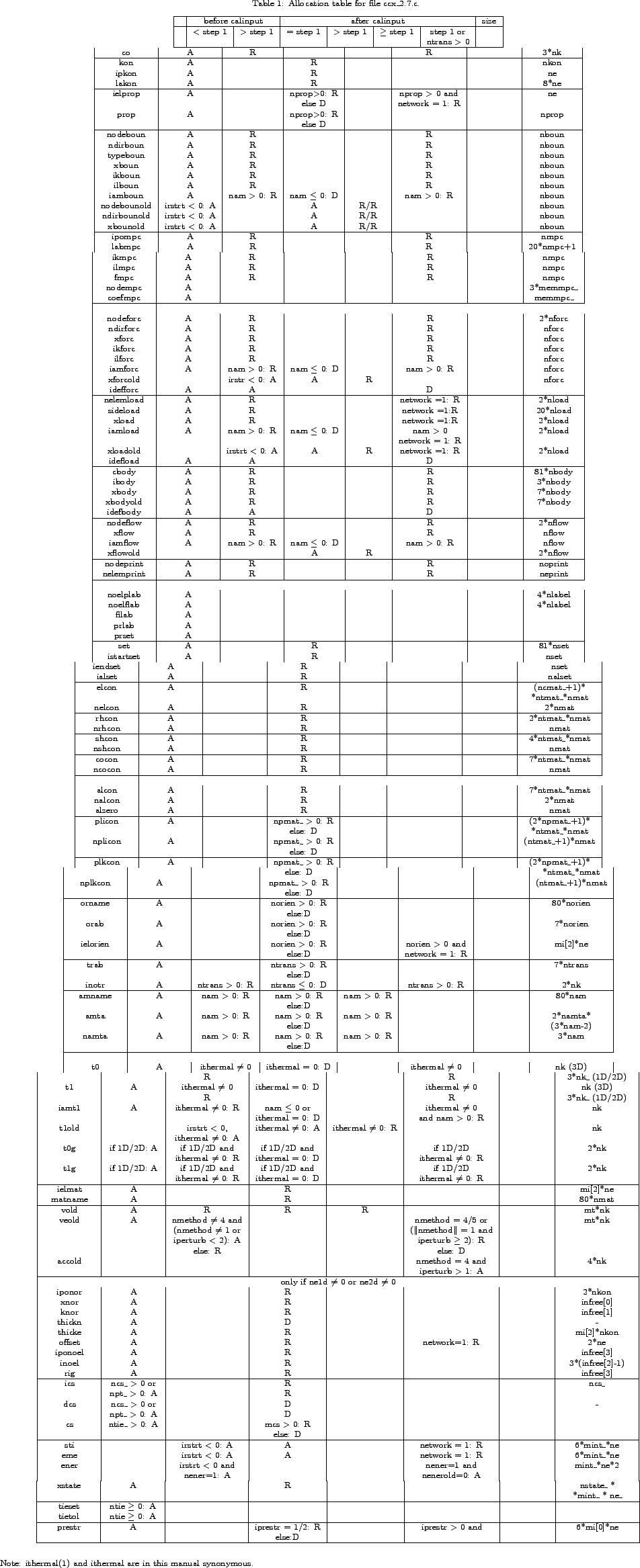



Next: Homogeneous linear equations
Up: Reading the step input
Previous: Reading the step input
Contents
The first one is the cataloguing algorithm for SPC's (single
point constraints, *BOUNDARY). Let's say a boundary condition m is defined for node i in
direction j,
 , direction 0 stands for temperature, directions 1
to 3 for translations in global x-, y- and z- direction, direction 4 stands
for static pressure, directions 5 to 7
stand for rotations about the global x-, y- and z-axis. Then a degree of
freedom
idof
, direction 0 stands for temperature, directions 1
to 3 for translations in global x-, y- and z- direction, direction 4 stands
for static pressure, directions 5 to 7
stand for rotations about the global x-, y- and z-axis. Then a degree of
freedom
idof is assigned to this boundary condition. Then, it is
stored at location k in the one-dimensional field ikboun, where all previous boundary
degrees of freedom are stored in numerical order such that
ikboun
is assigned to this boundary condition. Then, it is
stored at location k in the one-dimensional field ikboun, where all previous boundary
degrees of freedom are stored in numerical order such that
ikboun idof
idof ikboun
ikboun . Furthermore the number of the boundary
condition (m) is stored in ilboun:
ilboun(k)=m, and the node of the boundary
condition, its direction and value are stored in the one-dimensional fields
nodeboun, ndirboun and xboun:
nodeboun
. Furthermore the number of the boundary
condition (m) is stored in ilboun:
ilboun(k)=m, and the node of the boundary
condition, its direction and value are stored in the one-dimensional fields
nodeboun, ndirboun and xboun:
nodeboun ,
ndirboun
,
ndirboun and
xboun
and
xboun value. If an amplitude definition applies to
the boundary condition, its number
value. If an amplitude definition applies to
the boundary condition, its number  is stored in the one-dimensional field
iamboun:
iamboun
is stored in the one-dimensional field
iamboun:
iamboun .
.
The SPC type is stored in the one-dimensional field typeboun. SPC's can be of
different types, depending on whether the were defined by a genuin *BOUNDARY
CARD, or introduced for other reasons. The field typeboun is a
one-dimensional character*1 field. Other reasons to introduce SPC's are:
- fixing of the midplane in expanded plane stress/plane strain/axisymmetric
elements
- taking care of the inhomogeneous term in nonlinear MPC's such as the
PLANE *MPC, the STRAIGHT *MPC, a
*RIGID BODY definition or USER *MPC.
The corresponding type code is:
- B = prescribed boundary condition
- M = midplane constraint (plane stress/plane strain/axisymmetric elements)
- P = PLANE MPC
- R = RIGID BODY definition
- S = STRAIGHT MPC
- U = USER MPC
The total number of boundary conditions
is stored in variable nboun.
Consequently, ikboun
contains all degrees of freedom of the boundary conditions in numerical
order, and ilboun contains the corresponding boundary condition numbers. This
assures that one can quickly check whether a given degree of freedom was used
in a SPC. For example, if the SPC's look like:
*BOUNDARY
8,1,1,0.
10,1,2,0.
7,3,3,-1.
the fields look like:
nodeboun ndirboun ndirboun xboun xboun |
(192) |
typeboun ikboun ikboun ilboun ilboun |
(193) |
and nboun=4.
Finally, the following one-dimensional fields are also used:
- nodebounold: contains the node numbers of the SPC's at the end of
the last step
- ndirbounold: contains the directions of the SPC's at the end of the last
step
- xbounold: contains the values of the SPC's at the end of the last step,
or, if this is the first step, zero values.
- xbounact: contains the values of the SPC's at the end of the present
increment, or, for linear calculations, at the end of the present step. The
field xbounact is derived from the fields xbounold and xboun by use of the
present time and/or amplitude information. How this is done depends on the
procedure and is explained later on.
- xbounini: contains the values of the SPC's at the end of the last
increment, or, if this is the first increment in the first step,
zero's. This field is used for nonlinear calculations only.
Notice that among the boundary conditions SPC's are somewhat special. They are
sometimes called geometric boundary conditions to distinguish them from the
natural boundary conditions such as the application of a concentrated or
distributed load. To remove a natural boundary condition, just set it to
zero. This is not true for geometric boundary conditions: by setting a SPC to
zero, the corresponding node is fixed in space which usually does not
correspond to what one understands by removing the SPC, i.e. free
unconstrained motion of the node. Therefore, to remove a SPC the option OP=NEW
must be specified on the *BOUNDARY keyword card. This removes ALL SPC
constraints. Then, the constraints which the user does not wish to remove must
be redefined. Depending on the procedure (*STATIC, *DYNAMIC...), the change of
SPC's is applied in a linear way. This means that the old SPC information must
be kept to establish this linear change. That's why the fields nodebounold and
ndirbounold are introduced. The relationship between the old and new SPC's is
established in subroutine spcmatch, called from ccx_2.7.c.




Next: Homogeneous linear equations
Up: Reading the step input
Previous: Reading the step input
Contents
guido dhondt
2014-03-02
 , direction 0 stands for temperature, directions 1
to 3 for translations in global x-, y- and z- direction, direction 4 stands
for static pressure, directions 5 to 7
stand for rotations about the global x-, y- and z-axis. Then a degree of
freedom
idof
, direction 0 stands for temperature, directions 1
to 3 for translations in global x-, y- and z- direction, direction 4 stands
for static pressure, directions 5 to 7
stand for rotations about the global x-, y- and z-axis. Then a degree of
freedom
idof xboun
xboun
 ikboun
ikboun ilboun
ilboun